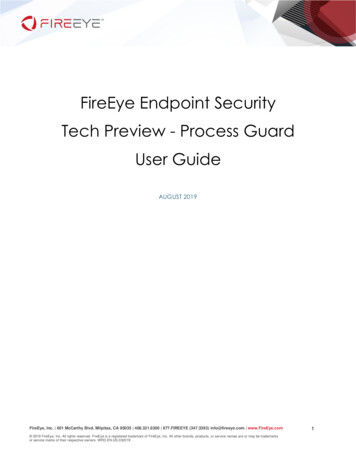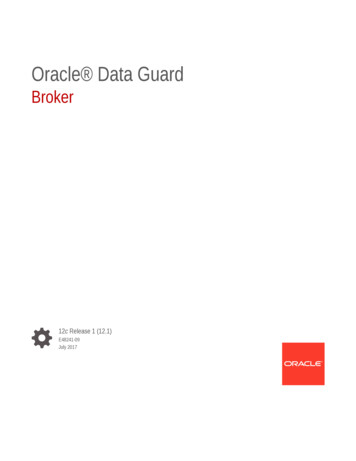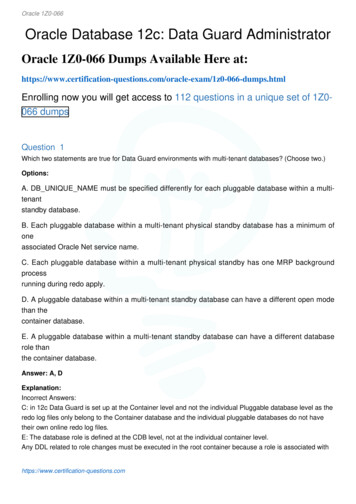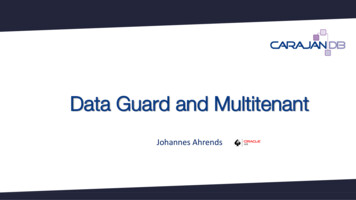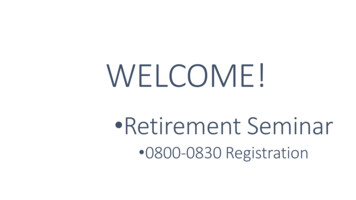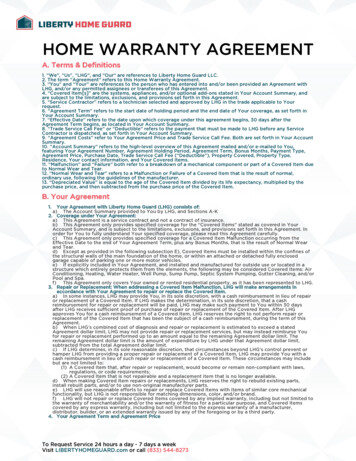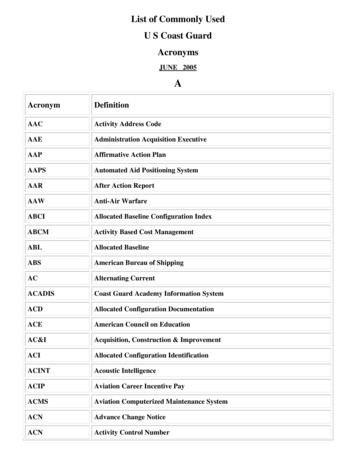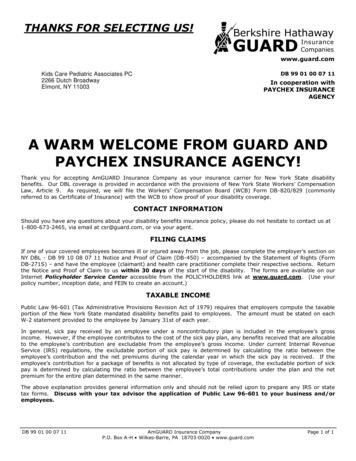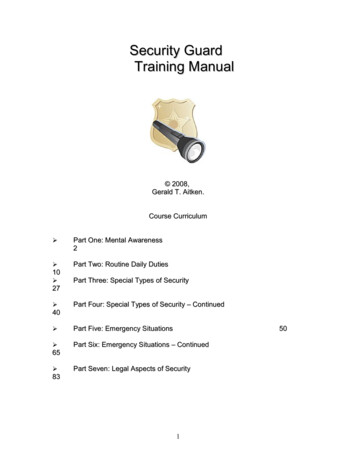
Transcription
Security GuardTraining Manual 2008,Gerald T. Aitken.Course Curriculum Part One: Mental Awareness2 Part Two: Routine Daily Duties10 27 40Part Three: Special Types of SecurityPart Four: Special Types of Security – Continued Part Five: Emergency Situations Part Six: Emergency Situations – Continued65 8350Part Seven: Legal Aspects of Security1
Part One: Mental Awareness Security AwarenessEthicsProfessionalismProfessional ImagePublic Relations2
Security Awareness SECURITY AWARENESS is an attitude held by security personnel andnon-security client employees, which places a high value on detecting, deterringand reporting security exposures such as crime, safety hazards, fire hazards,theft, intrusions, and vandalism. With security awareness, security personnel protect the client’semployees, property, guests and image and assist the client’s personnel andvisitors. With security awareness, non-security client employees are aware of thesecurity program’s goals and methods and support the security program, abidingby its policies.Employees have constant contact with their immediate surroundings,more so than security people. So, employees can help detect: Fire hazards (faulty electrical equipment, combustible materials) Crime, theft and violence potential (strangers in the area, unobservedexits)Safety hazards (worn out equipment, obstructions, dangerous spills, faultyalarms) 3
Three steps you should take when you notice a potential hazard: Identify it Report it to your supervisor Discuss it with your supervisor, to come up with a solution that eliminatesthe problemHow to cultivate security awareness among client employees: Conscientious, visible security officers Fair enforcement Let people know the reasons why – the types of misfortunes that can beprevented Recruit employee support during hiring process and through periodicmemorandums, meetings and presentationsSECURITY OFFICER ETHICSConsequences of unethical or unprofessional behavior: Being snubbed by colleagues and superiorsPassed over for promotionTerminationRevocation of Security Officer LicenseCivil and criminal liability Security Officer Ethics Involve:Exemplary conductMaintaining a safe and secure workplaceProper dress, grooming and hygieneImpartial, fair, non-discriminatory toward everyoneRespond to client’s and employer’s needs4
Security Officer Ethics Involve:Enforce all lawful rules and policiesStrive for professional competenceRespect the client’s private property and that of employeesProtect confidential informationGood liaison with Firefighters, EMTs, Peace Officers and Police OfficersMaking ethical decisions to solve problems – working with your Supervisor Identify the problemDetermine required time frame for solutionConsider the desired outcome(s)Identify all optionsChoose the best optionImplement decisionOngoing evaluation Causes of Unethical BehaviorSecurity officer is financially unstableSecurity officer has poor character (not screened)Resistance to change (not embracing new training)Fatigue (taking shortcuts; path of least resistance)Sexual conflicts of interestConflicts of interest caused by moonlighting Elements of ProfessionalismGood manners (don’t interrupt, give praise, stand when greeting)Professional appearanceIntegrity (doing the right thing)Seek professional educationVigilance (helping protect employees, guests, property and image)Embrace your training opportunitiesHelpfulness (provide superior customer support)Accumulate experienceStrive for excellence5
Security professionals are: Informed about the professionHonest, precise, exact, detailed and factualAlert and observantImpartial and objectiveAccommodating and responsiveSincereLoyalHard-workingProfessional Image Dress in full uniformPolished black shoesBlack beltDark socksBe sparing with jewelry, makeup or cologneNo purses for womenClip-on tie (safer than regular tie)Wear only approved coats or jacketsYour breast badge should always be visibleClean body hygiene, hands, fingernailsHair short, combed, trimmedObserve your employer’s facial hair policyWear your cap on patrol6
Professional Image Positive attitudeAlert at all timesProfessional body languageCorrect EnglishGood mannersPublic Relations Any time you interact with clients, guests, the media, or the public, you areinvolved in PUBLIC RELATIONS. Public relations involves face to face contact, the telephone, anddocuments in writing. The type of PR you’ll be involved with most frequently isface to face. The Security Officer is frequently the first point of contact with the public.3 Main Purposes of Good Public Relations Protect the client’s imageEstablish and maintain good willMake it easier to accomplish your job tasksYou may need to establish good public relations with: Fellow officers and SupervisorsClient staff and guestsDelivery personnel, truck drivers, cabbies, train crewsPolice, Fire, EMTContractors7
You may also need to establish good public relations with: Client Executives and Security ManagerUnion members and officialsJuvenilesCrime victimsMedia personnelThe general publicInteracting with the Media Direct the media to your client’s public information personNever give an interviewDo not say “No comment”Never be rude to the mediaPublic Relations Techniques Give superior serviceGreet people and welcome them. Ask “How may I help you?”Be attentive to the other person’s needsShow empathy and respect to people who have complaintsBe a helper; be responsive; VOLUNTEER to help othersRemember people’s names and address them by nameBe understandingAppear truly concerned8
Good professional appearance and imagePublic Relations Techniques Make the person feel secureSkillfully redirect the person into appropriate behavior, rather than bullythem Never tell someone they are wrong; don’t argue; empathizeBe comfortingBe a “can-do” problem-solverAccentuate the positiveGive only relevant information as requestedBe a pleaserBe businesslike Show respect; make the other person feel important Be polite, pleasant, and hospitable Never be unwilling to help (avoid the “that’s not our job” syndrome) Know the inner workings of other departments besides security, so youcan make referrals “Win-Win” mutual needs satisfaction, not “Win-Lose” 9
Part Two: Routine Daily Duties Post OrdersPatrollingObservation and MemoryReport WritingCommunications10
Post OrdersEach work site to which you will be assigned will have a set of POSTORDERS at the main security desk. The Post Orders explain your duties and the client’s expectations ofSecurity Officers. You must read and sign the Post Orders. You are responsible for theinformation therein. Review the Post Orders periodically for new updates and to refresh yourmemory. Post Orders include: Officer’s duties, by day of week, shift, and timeHow to make patrol rounds; clock key locationsTelephone procedures and employee phone directoryEmergency procedures and phone numbersPost opening and closing proceduresAccess control proceduresAlarm systems mapEmergency exits mapDaily Activity Reports, Incident Reports, etc. – how to fill them outTruck gate proceduresParking lot / traffic control procedures11
Purposes of Patrol: Detect and prevent fire, safety and health hazardsDetect, prevent and deter theft, intrusion, vandalism, or other criminal orunauthorized activity Investigate as directed by the central alarm panel, dispatcher orsupervisor Assist plant employees or management Test and inspect the physical security system Observe and report unusual events Respond to emergencies or outages Observe and report violationsType of Foot Patrols Internal (conducted inside the facility)Stationary (done within a restricted area)Security/Fire (inspecting fire alarms and alarm doors)Types of Mobile Patrols External (yards, streets, sidewalks, parking lots)High Visibility (to deter security threats)12
2 Major Principles of Patrol Vary the routeVary the timeThese measures are to prevent your patrols from becoming routine andpredictablePreparing for Patrol Get to know the client facility wellElectrical controlsDoors and windowsEmergency equipmentTelephonesWater shut-off valvesFire alarms and extinguishersHazardous materialsReview any new reports, logs, or memorandums from previous shiftInspect your vehicleCheck your flashlight and watchman clockWill your pen still write? Do you have a field notebook?Are you required to use a hard hat, earplugs, or safety glasses?Do you have your keys? Whistle? Radio or cell phone?13
To enhance your ability to detect unusual situations:Become familiar with the central alarm station (alarms and CCTV screens) Get to know the people in your patrol environment (professionally, notpersonally) Note existing cracked windows, doors ajar, scrape marks near doorknobs,etc. so they don’t present a false alarm Check the maintenance tags on equipment Get to know the maintenance and janitorial personnel and theirprocedures Communication while on PatrolListen before speaking into the radioDepress the speak button for a moment before and after speaking, toavoid truncation If an extended conversation is required, use the radio to request a landline Speak clearly and a little slower than normal Avoid unnecessary chatter Do not use foul language (plenty of neighbors have scanners) Tips for all Patrols (Foot and Mobile) Conduct a radio check before leavingCommunicate periodically with BaseAvoid distractions; be observantUse your field notebook; later, write accurate reportsBe cautiousAvoid being silhouetted (especially on foot patrol)14
Tips for Vehicular PatrolDon’t play the commercial radio loudAvoid smokingPark behind suspicious vehicles or at an anglePark legallyDo not transport others unless told to do soKeep the windows open slightly (so you can hear and smell) Don’t use the flashing lights or the siren unless there is a genuineemergency Use spotlights carefully Inspect your vehicle before leaving Lock your vehicle if you leave it Use sight, hearing, and smell Drive slowly and safely Observation and Memory SeeHearSmellTouchTasteRememberAssist your memory with field notebook and pen15
Exercise to Develop your Memory Study a photograph in a magazine. Then put it down, and write down allyour observations. Then go back and compare. As you become more accurate and complete, reduce your observationtime slightly and try again.Remembering Faces HairForeheadEyebrowsEyesNoseCheeks and Cheek BonesMouthChinComplexionNeckRemembering the Whole Person HairFace, Eyes, ComplexionAgeSexHeightWeight and Build16
Remembering the Whole Person HatShirtCoat or JacketTie, Turtleneck or CollarPants or SkirtShoes, Socks/StockingsAccessoriesPurposes of a Field Notebook Portable directory of contact and emergency names and phone numbersWrite down details of an incident or observationRefresh your memory when you return to baseAssist in writing security reportsDetect inconsistencies in eyewitness statementsInvestigative aidAn indication of officer’s work and competenceFeatures of a Field Notebook Cloth or glue bound, not loose-leaf (so pages cannot be inserted orremoved) Pages numbered sequentially Protected by a cover Small enough to fit in your pocket Large enough to write easilyYour Field Notebook Should Contain Phone Numbers of: Security Headquarters / Field OfficePolice, Fire, EMTLocal hospitalLabor RelationsSecurity Supervisors17
Client Supervisors Review your notes carefully before writing your reportMake notes as soon as possible after observation or incidentBe legibleAvoid abbreviationsNo personal notesDo not rip out pagesUse all pages and spacesBe completeDo not erase an error; draw a line through it and initial itBe systematicNo personal opinionsWhen Using a Field NotebookAt the scene of an incident note the following: First observations of the scene, including sketchesYour actions at the sceneThe actions of others at the sceneResults of any property searches or personal searchesName, phone, and address of all persons involvedNames of the other security personnel at the sceneNames and badge numbers of police, fire, EMTs at the scene18
The Purpose of Reports report) Document routine patrols and what you observed on patrol (shift report)Accurate and permanent recordDocument the shift – all duties carried out and events that occurred (shiftDetecting problem areasBasis for later statistical dataDocument a special occurrence (incident report)Indication of officer work and competenceSecurity Reports Must Be: ClearAccurateCompleteConciseLegiblePrompt6 Essential Elements of a ReportWhoWhatWhenWhereWhy (not opinion; facts only)How (not opinion; facts only)19
Security Reports are Intended for: Your Shift SupervisorYour Site CommanderSecurity Headquarters / Field OfficeYour client contactPossibly the courts (civil or criminal)Shift Reports (Daily Activity Reports) Distribute information from the Security Department to other departmentsInform your superiors of conditions at your facilityPoint out problems and potential problemsProvide details to superiors and authorities of various events andconditions that need their attention Suggest improvements Incident ReportsSafety concernsReport violationsDisciplinary mattersMedical responseFire investigationsTheft investigationsEyewitness statementsTraffic accidentsEvery Report Should Include: Reporting officer’s name, date, shift start and end times, locationExecutive SummaryDetailed chronologyFollow-up actions still pending20
Report Writing Tips Don’t rushThird person (“He entered the hallway.”)Legible handwritingAs soon as possible after the observation or eventNot later than end of shiftUse your field notesBlack ink (copies better than blue ink)Past tenseDetail events in chronological orderWhen paraphrasing do not
Security Officer Ethics Involve: Enforce all lawful rules and policies Strive for professional competence Respect the client’s private property and that of employees Protect confidential information Good liaison with Firefighters, EMTs, Peace Officers and Police Officers Making ethical decisions to solve problems – working with your Supervisor

